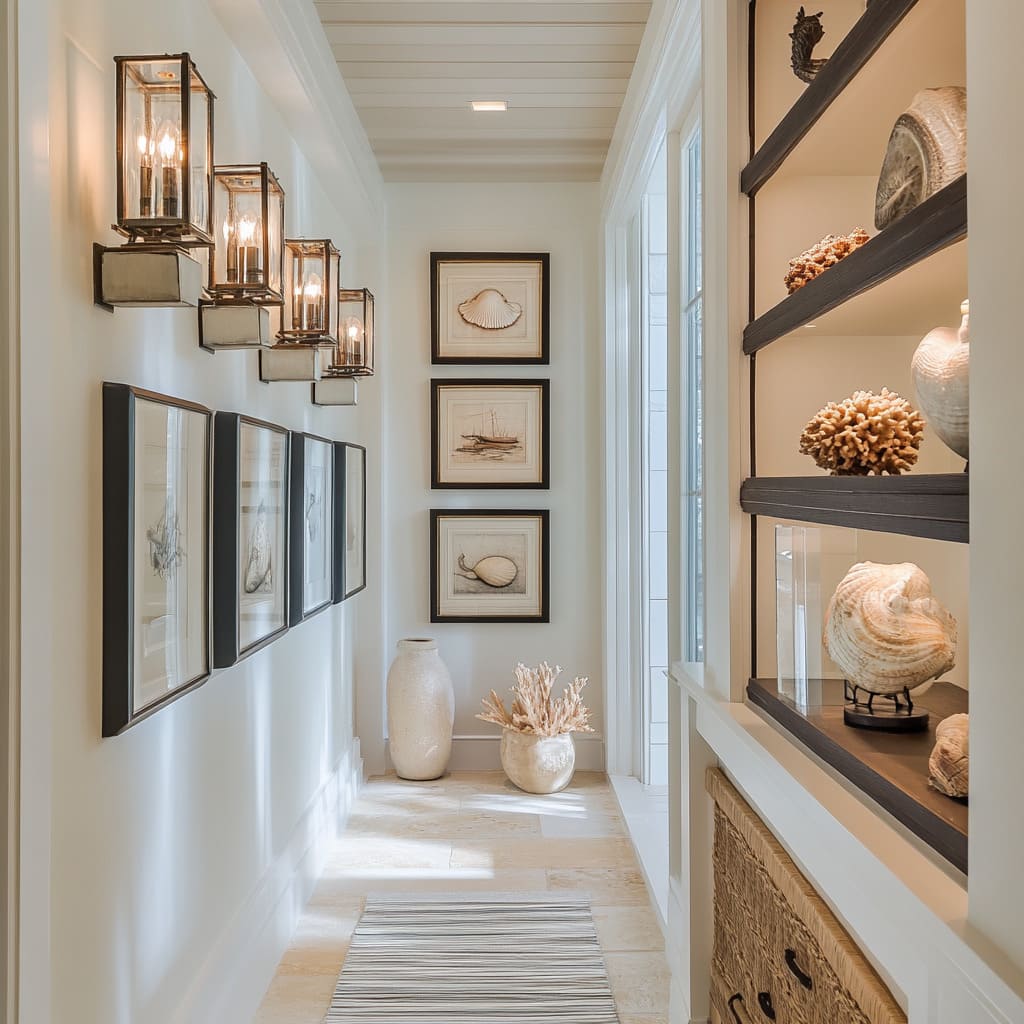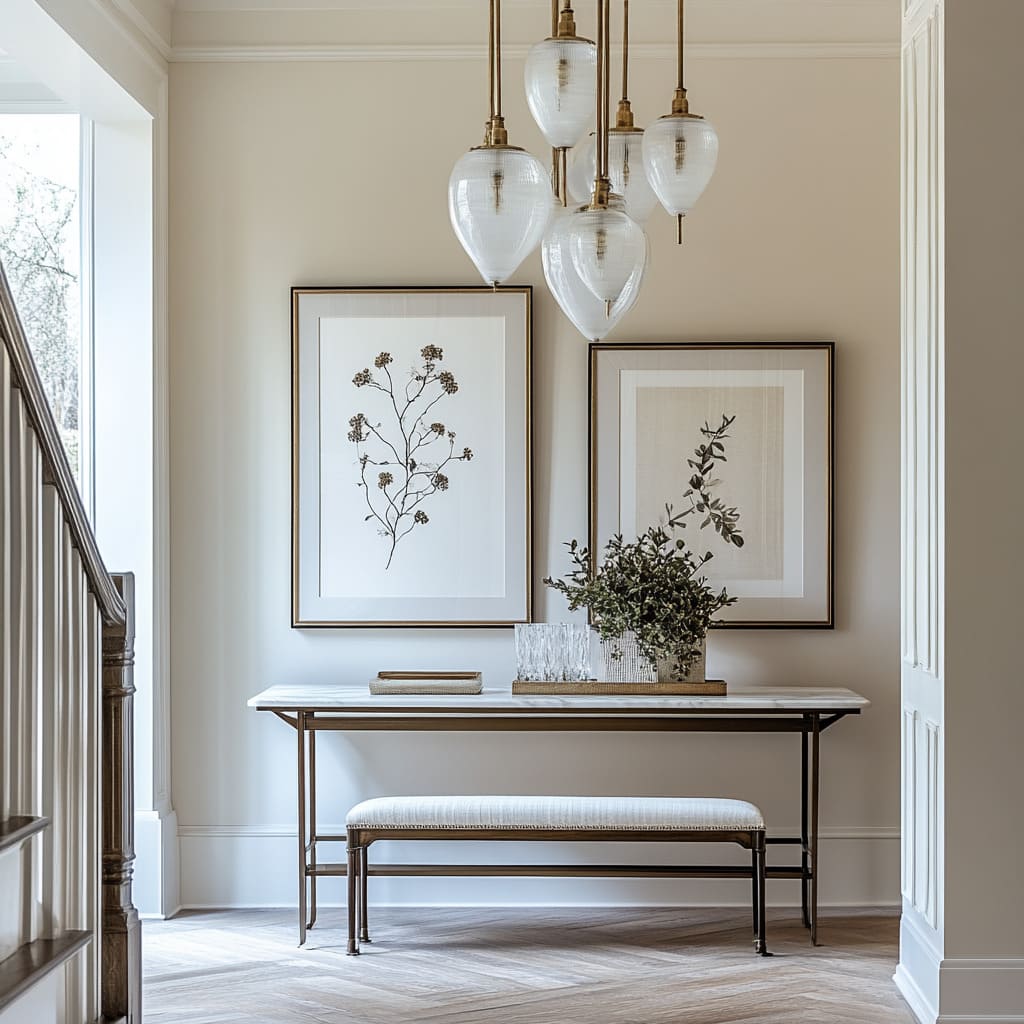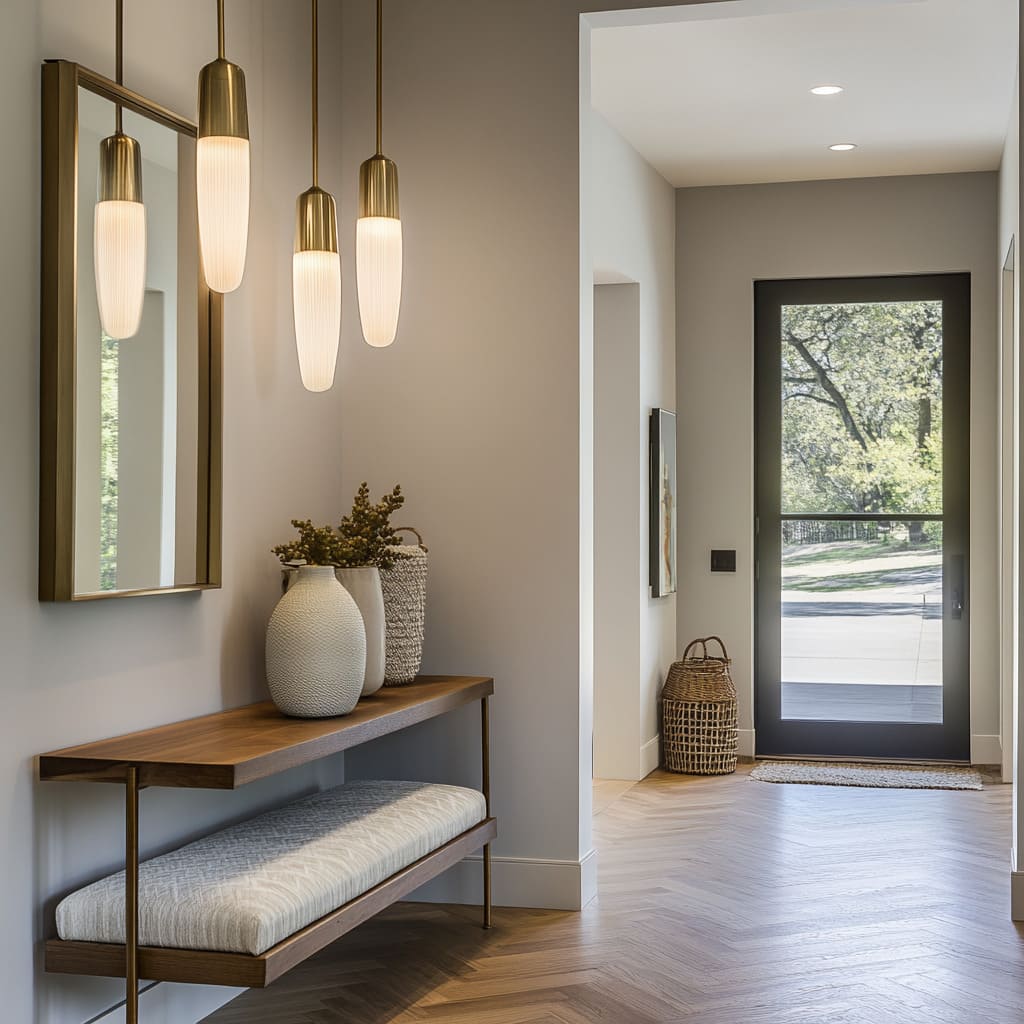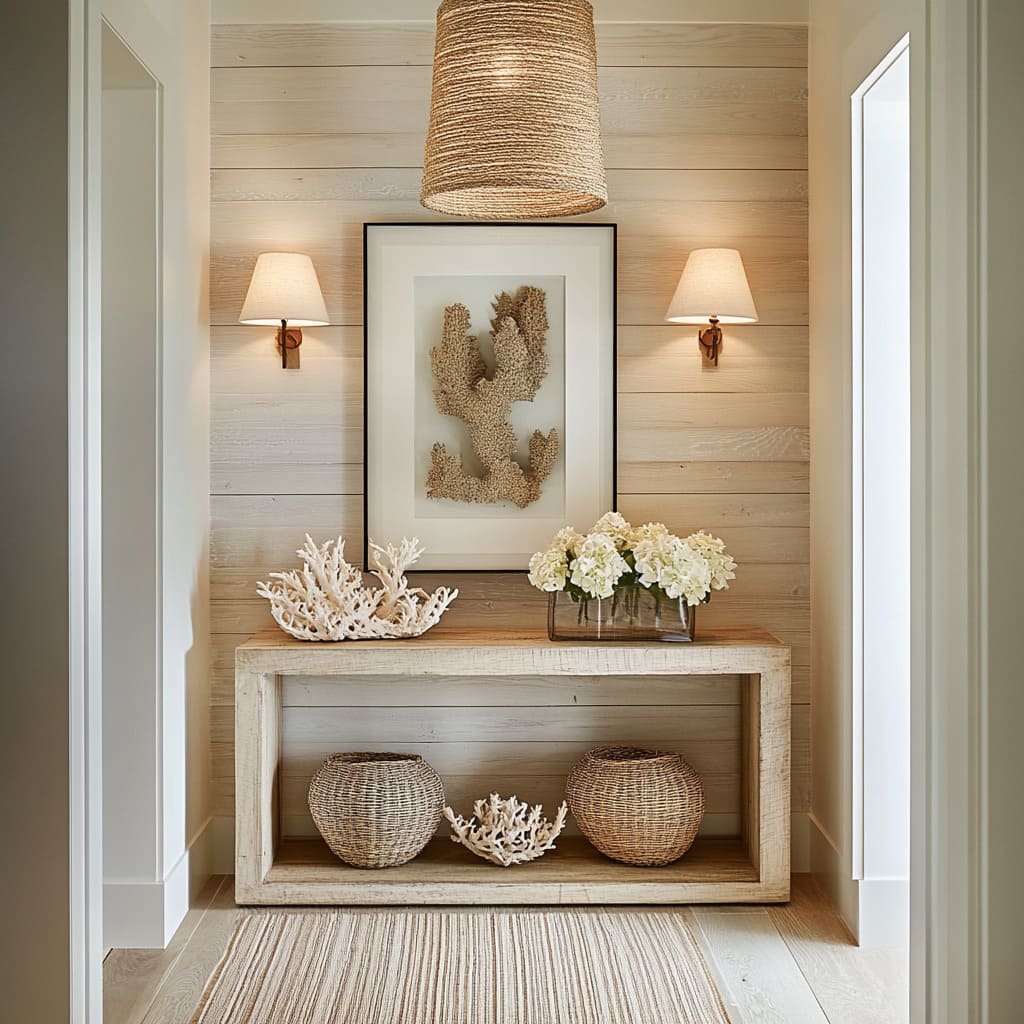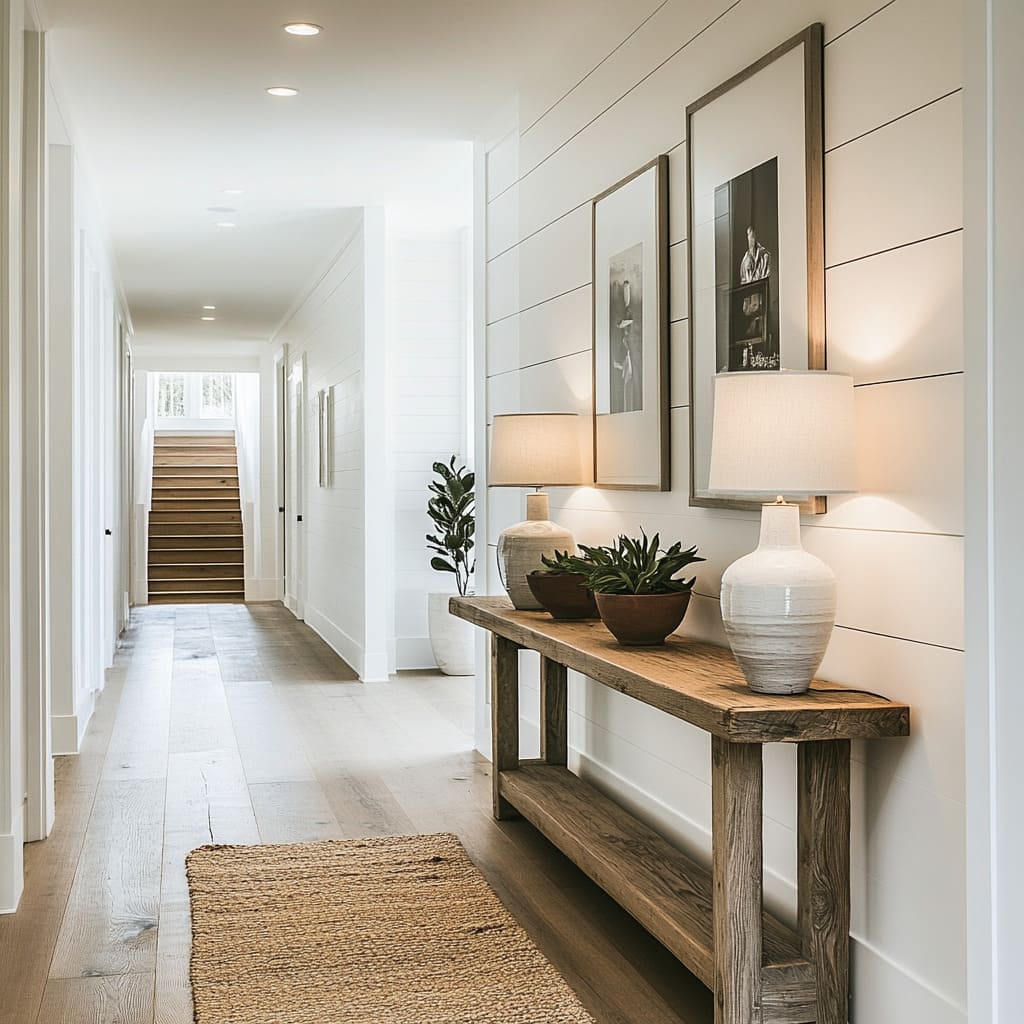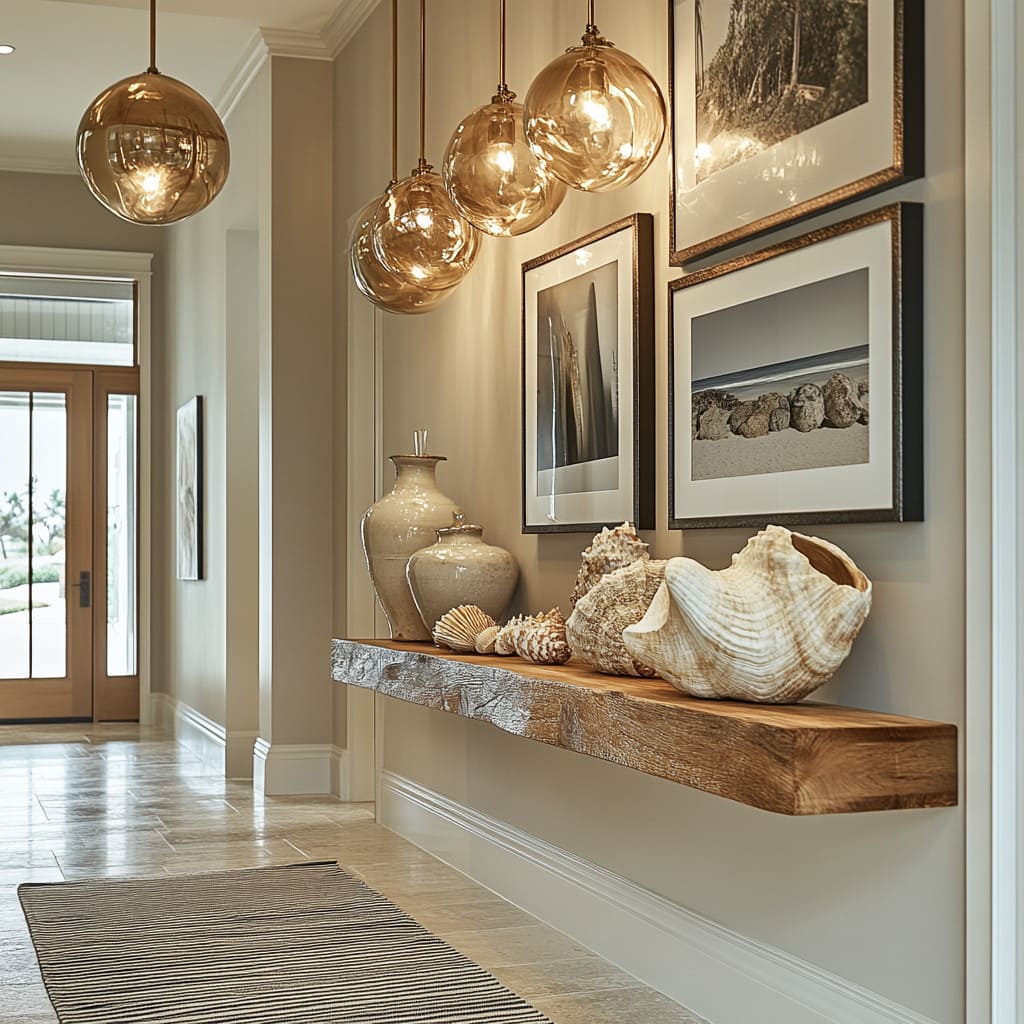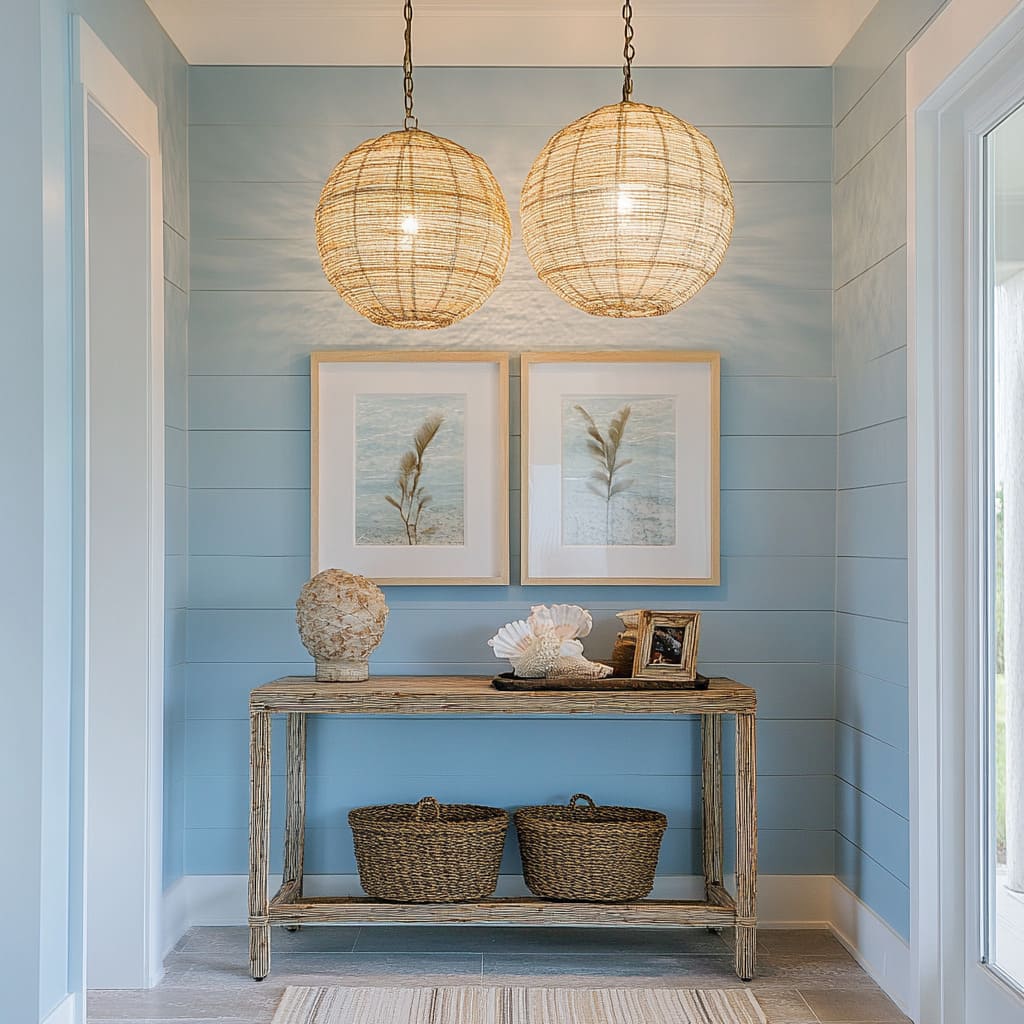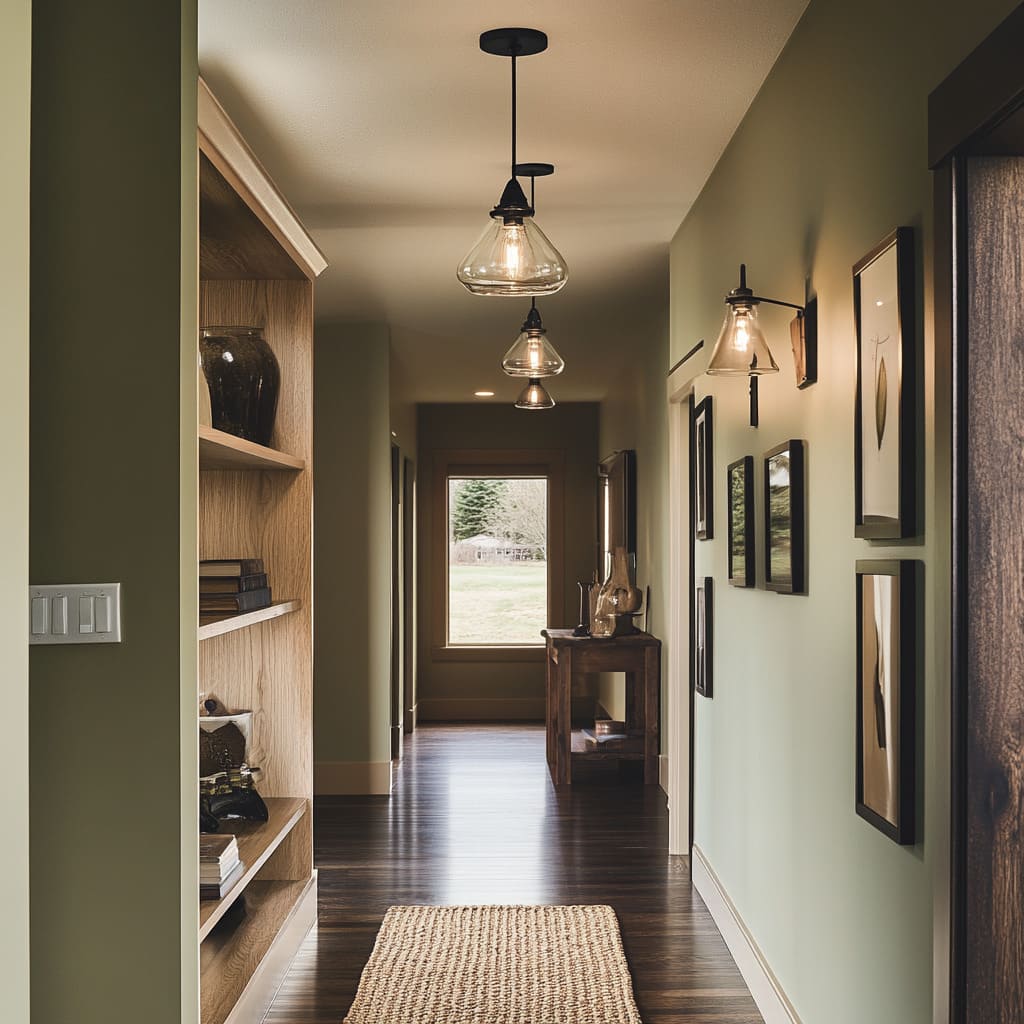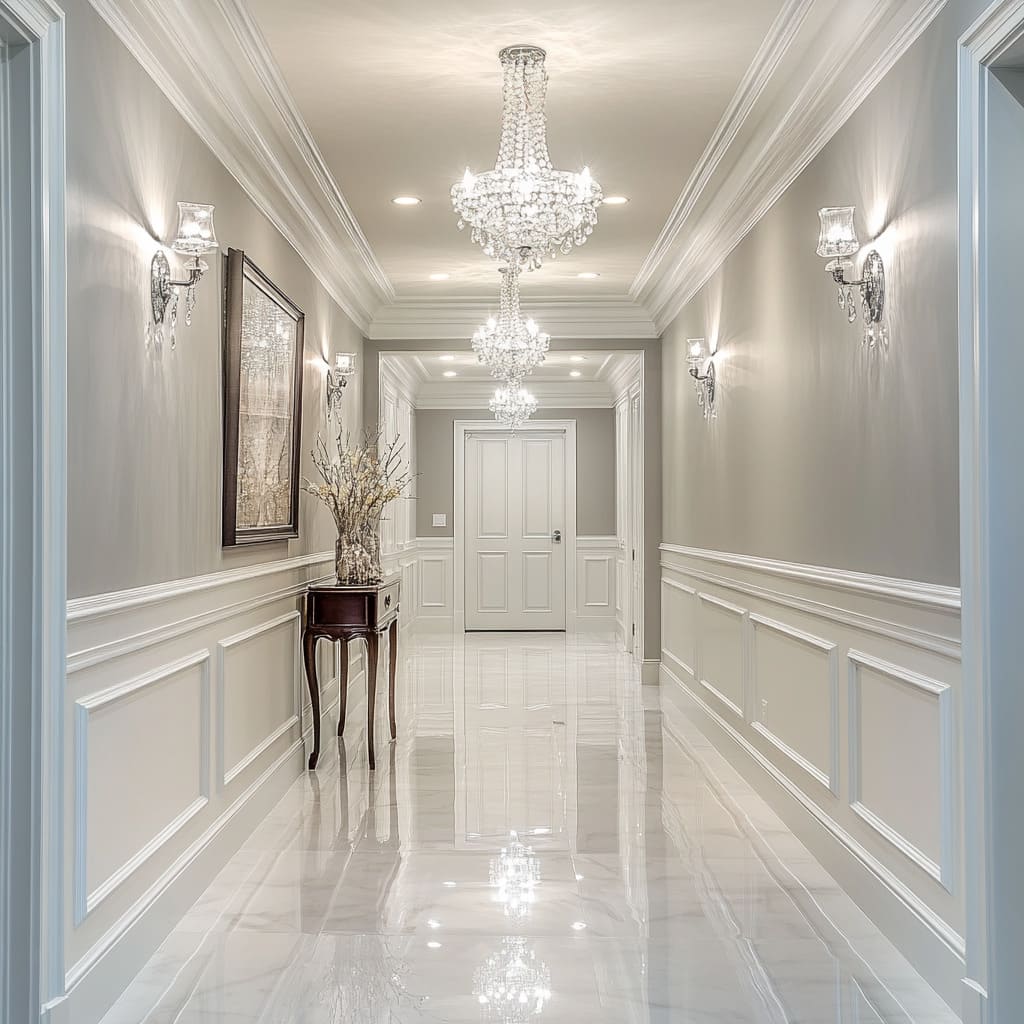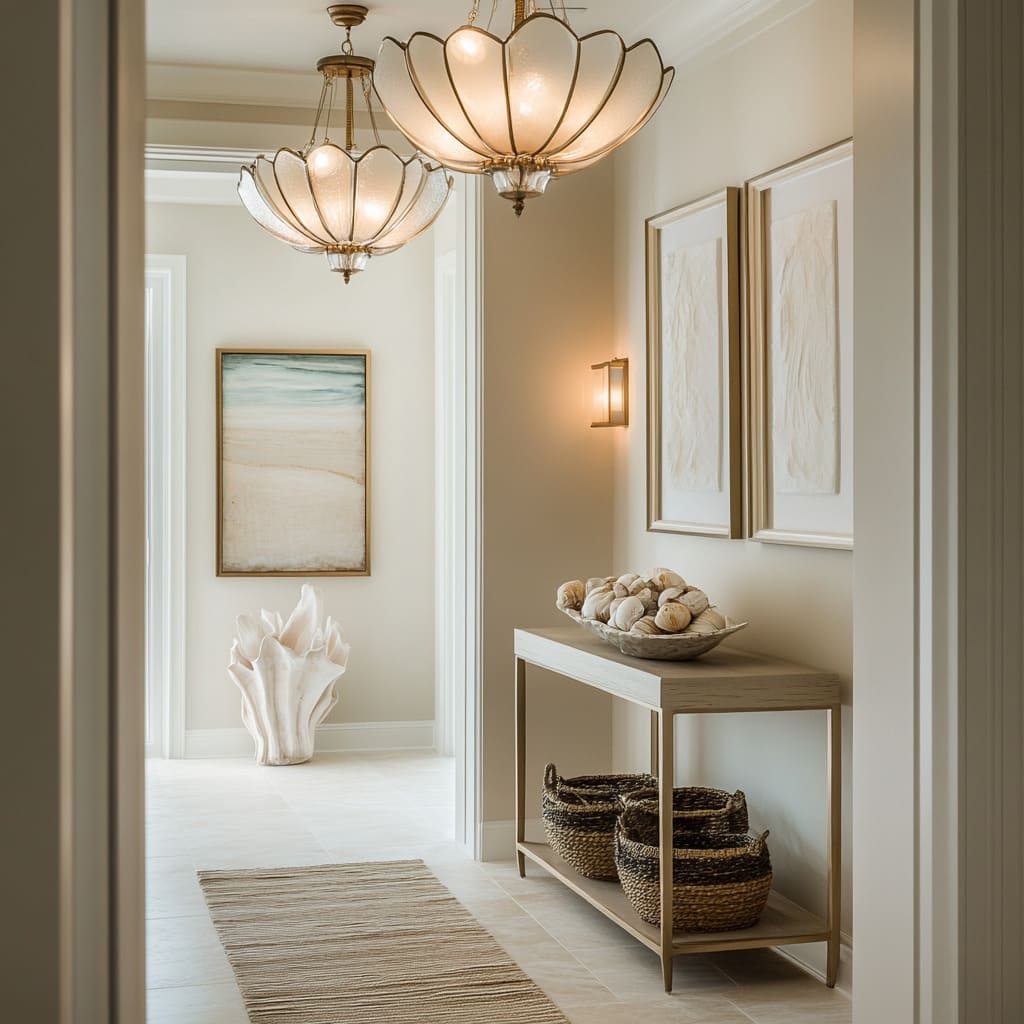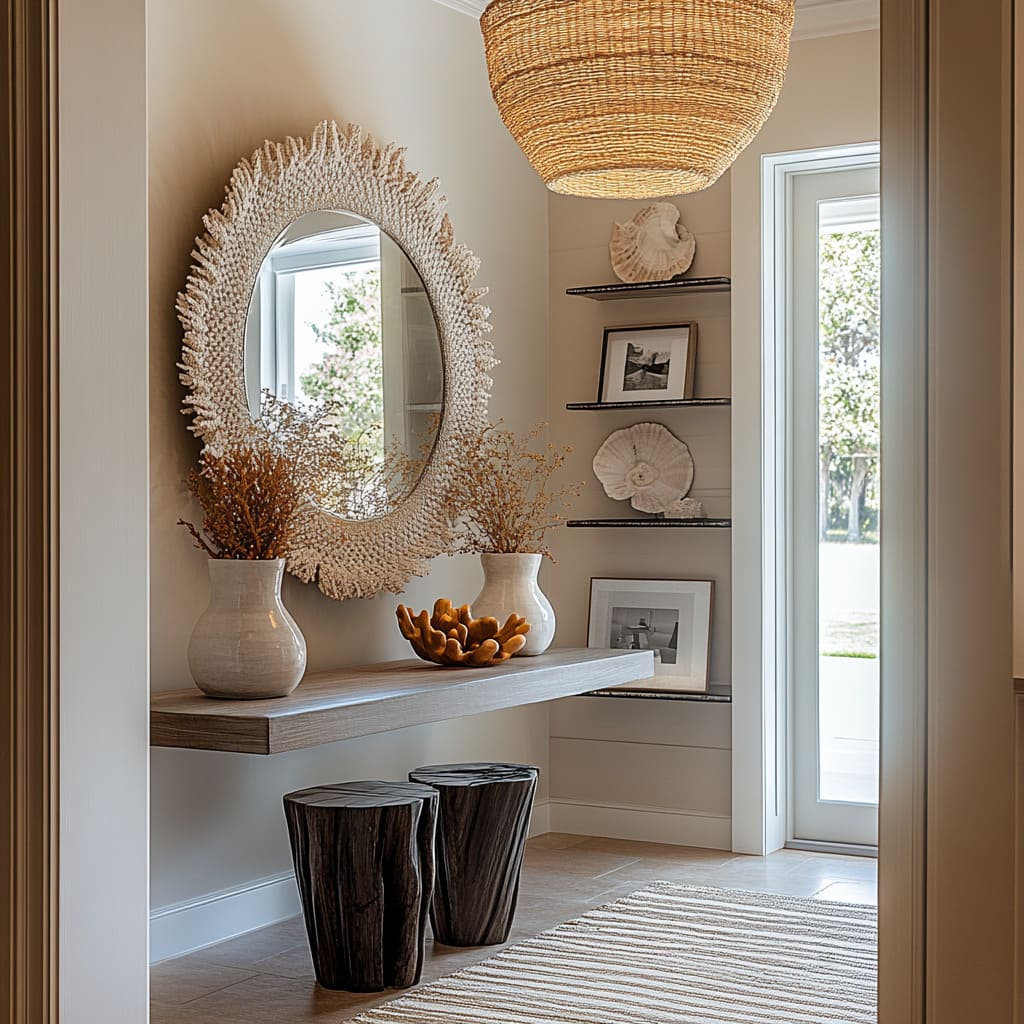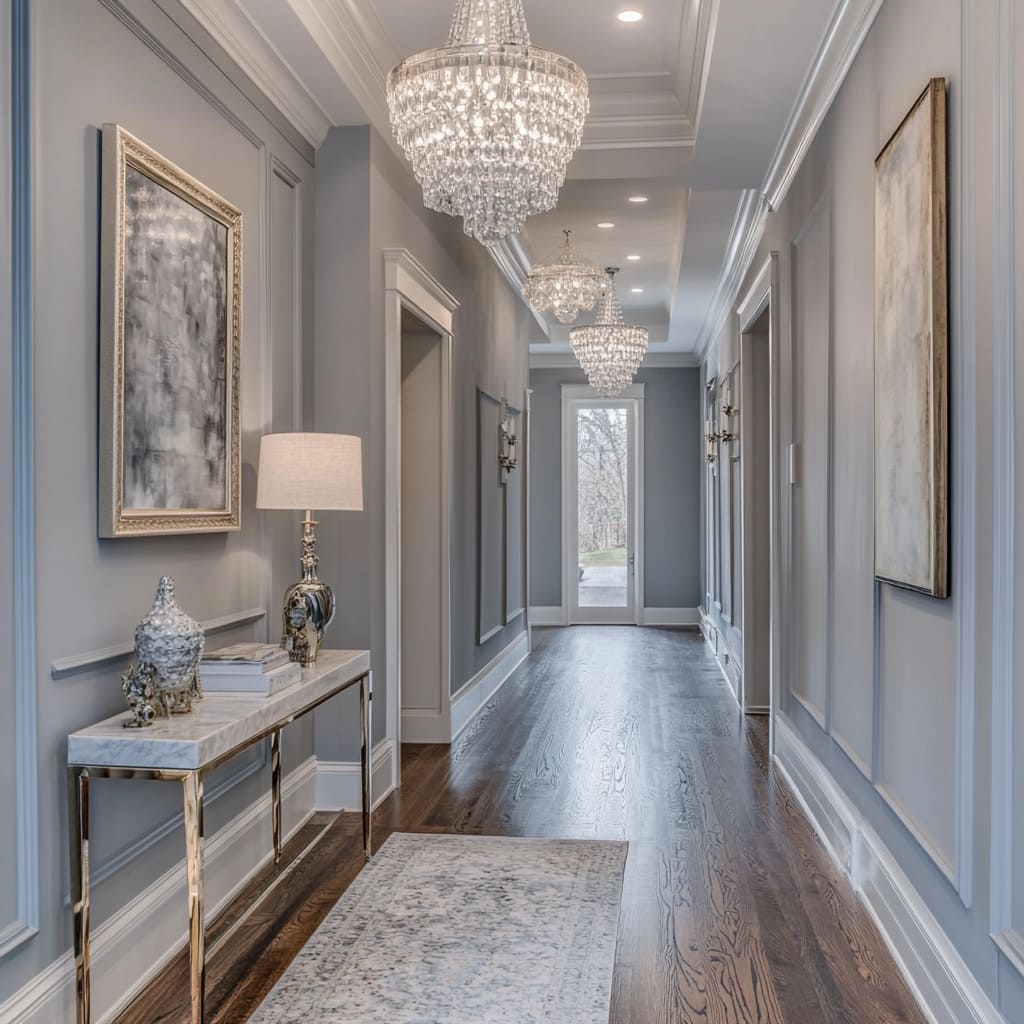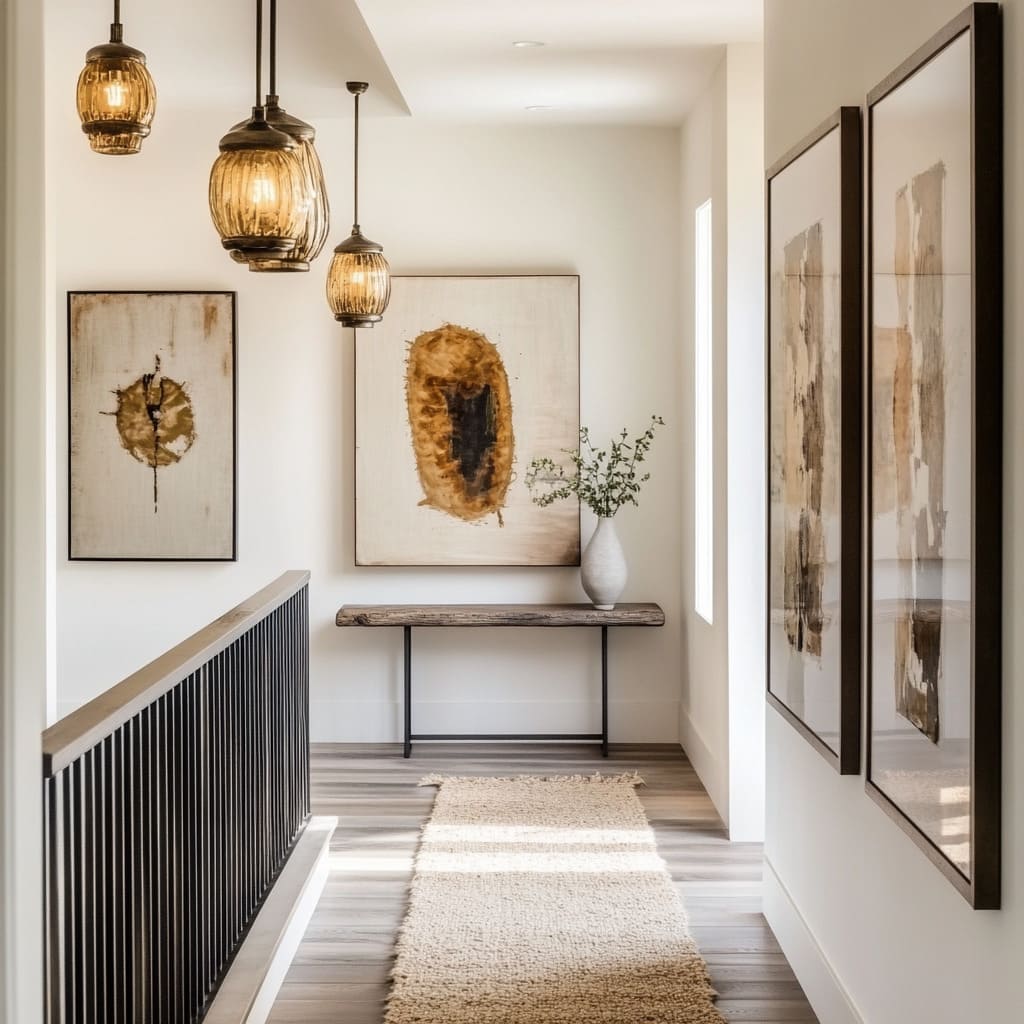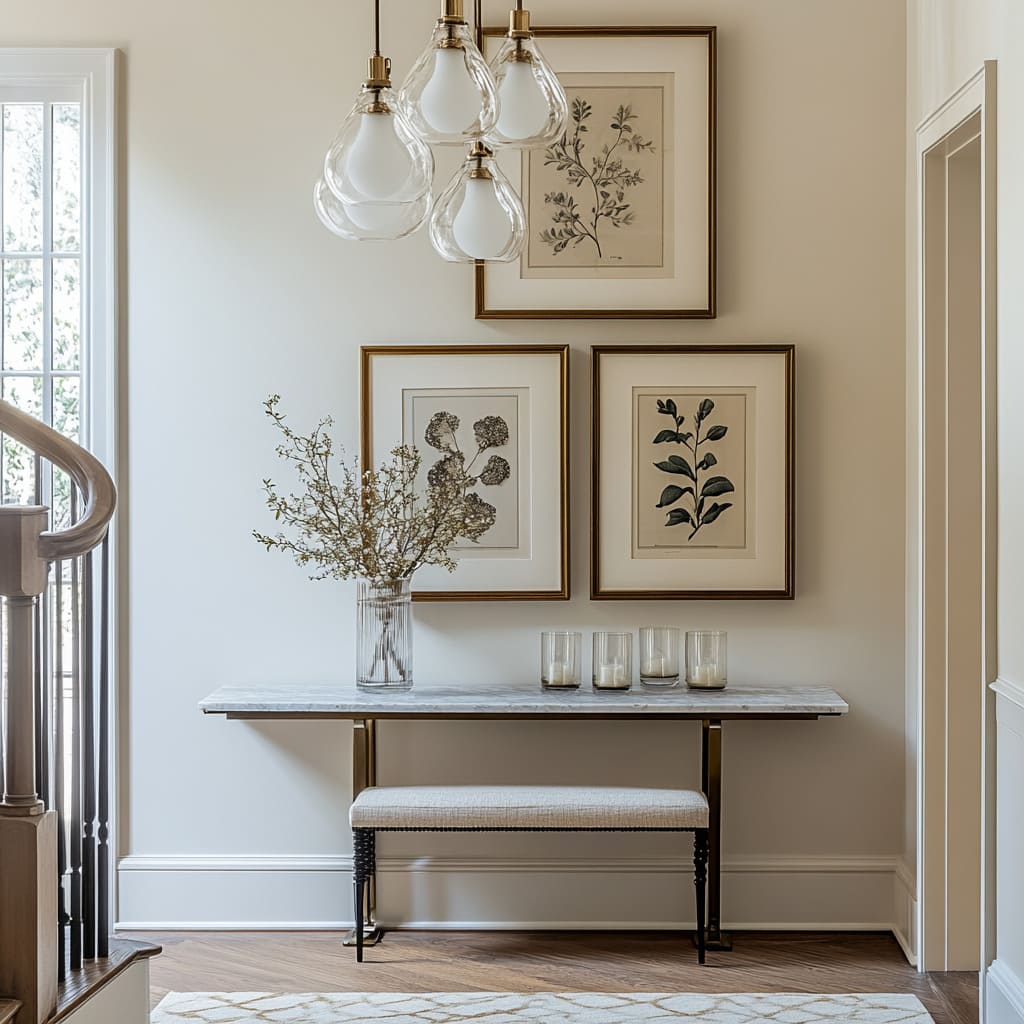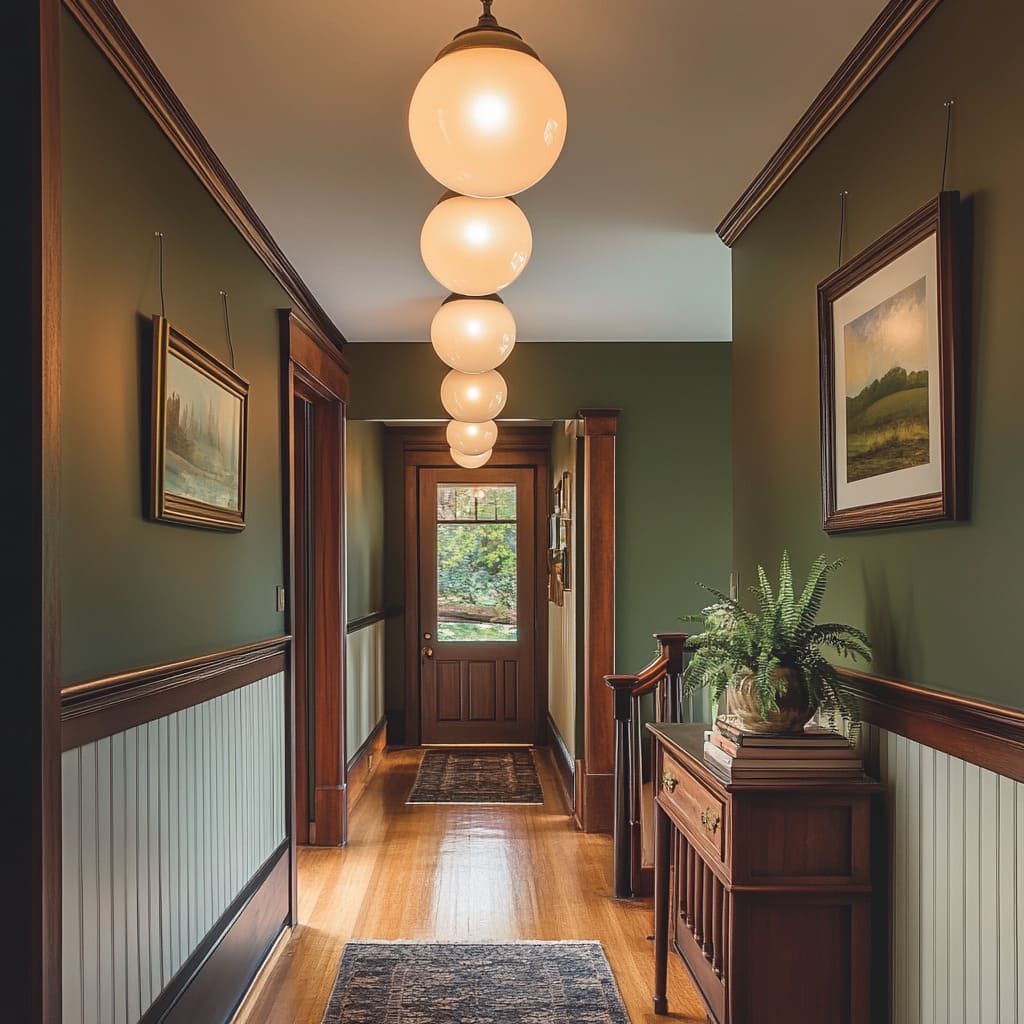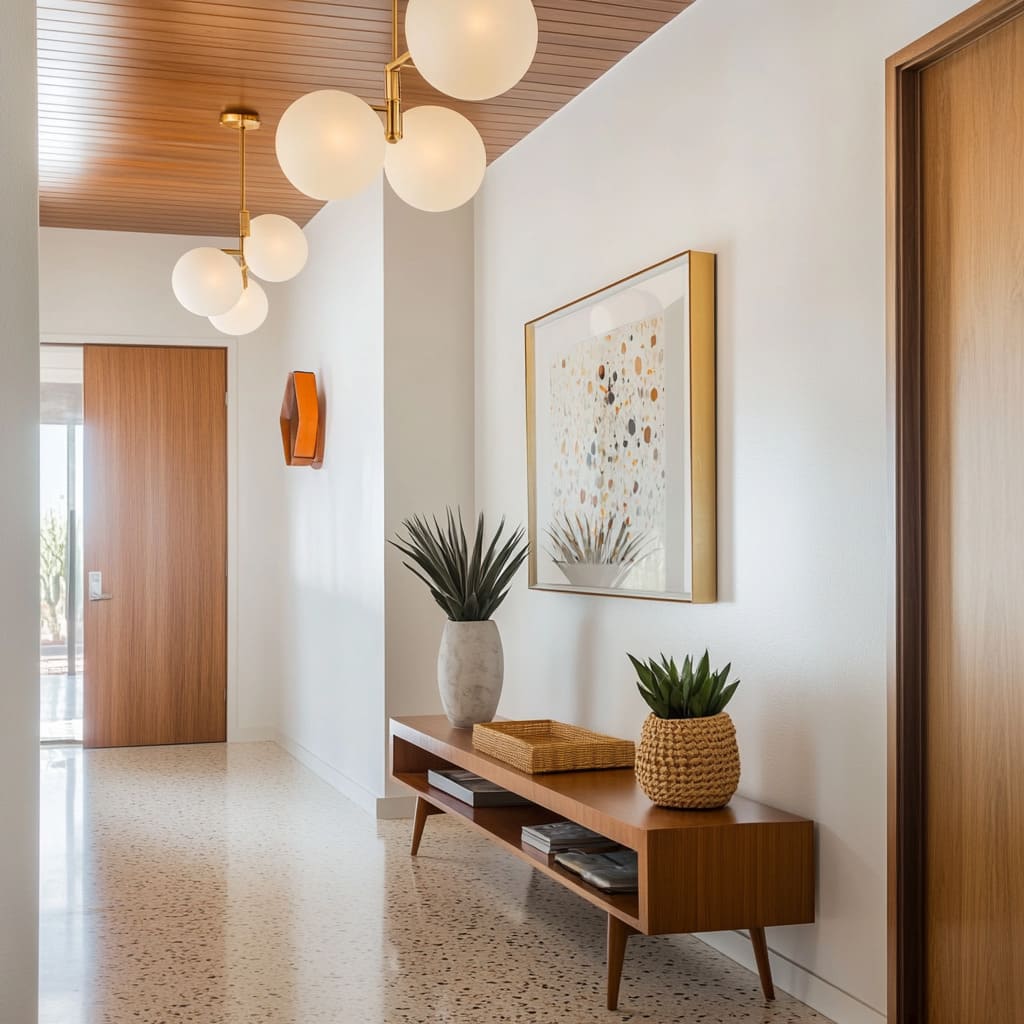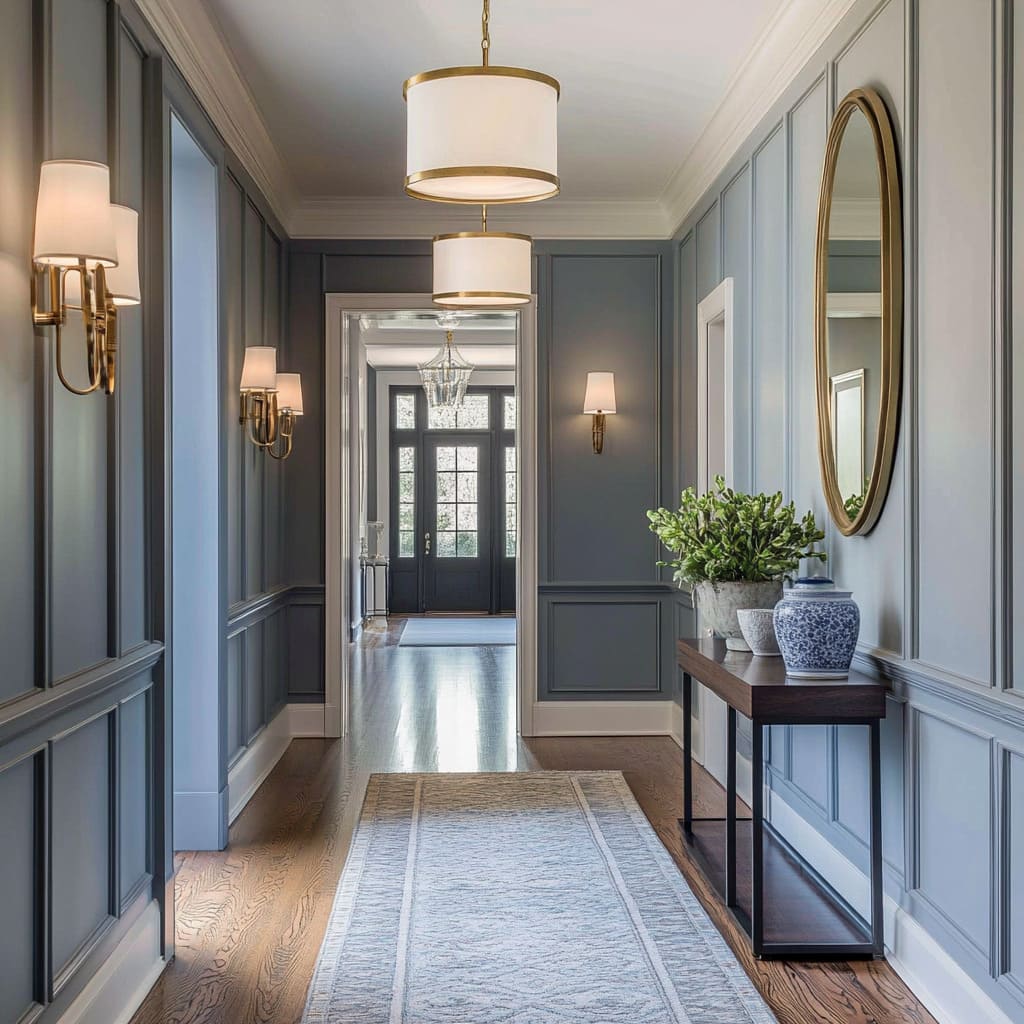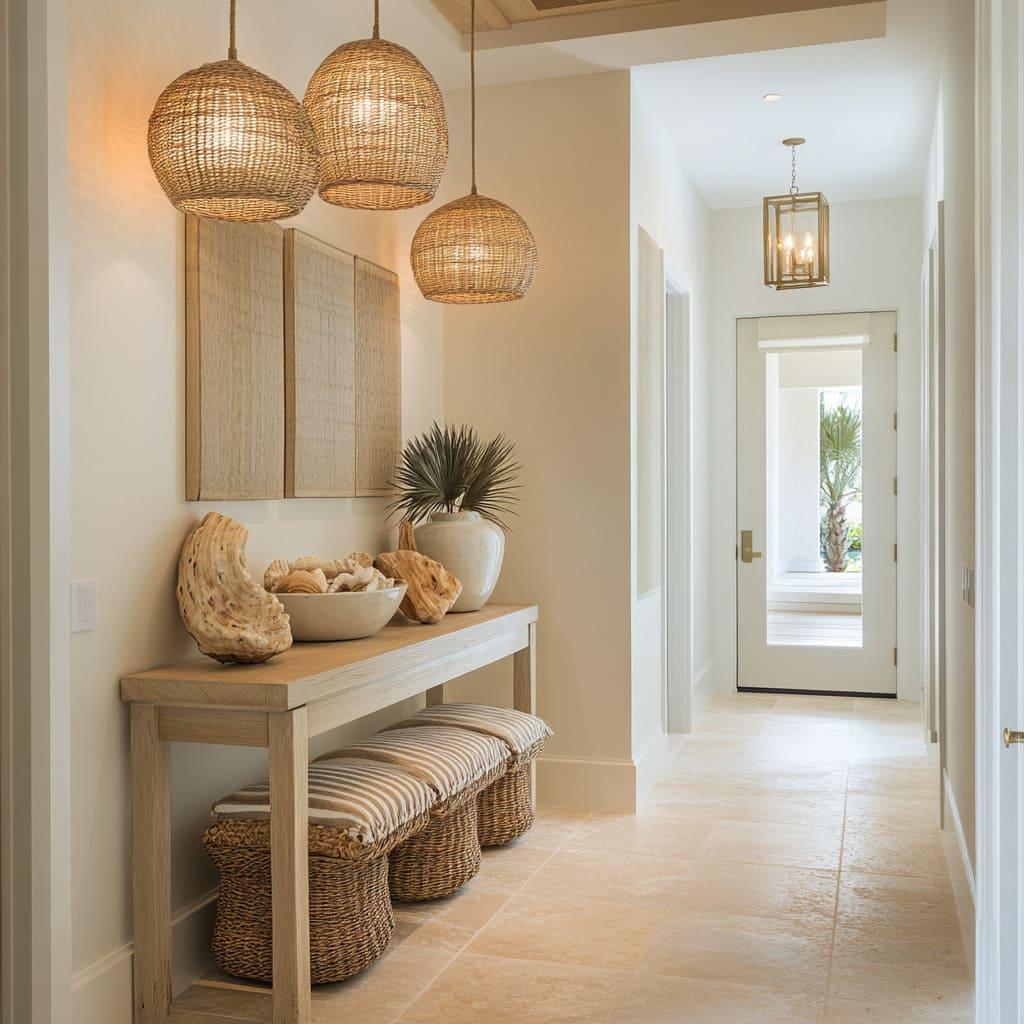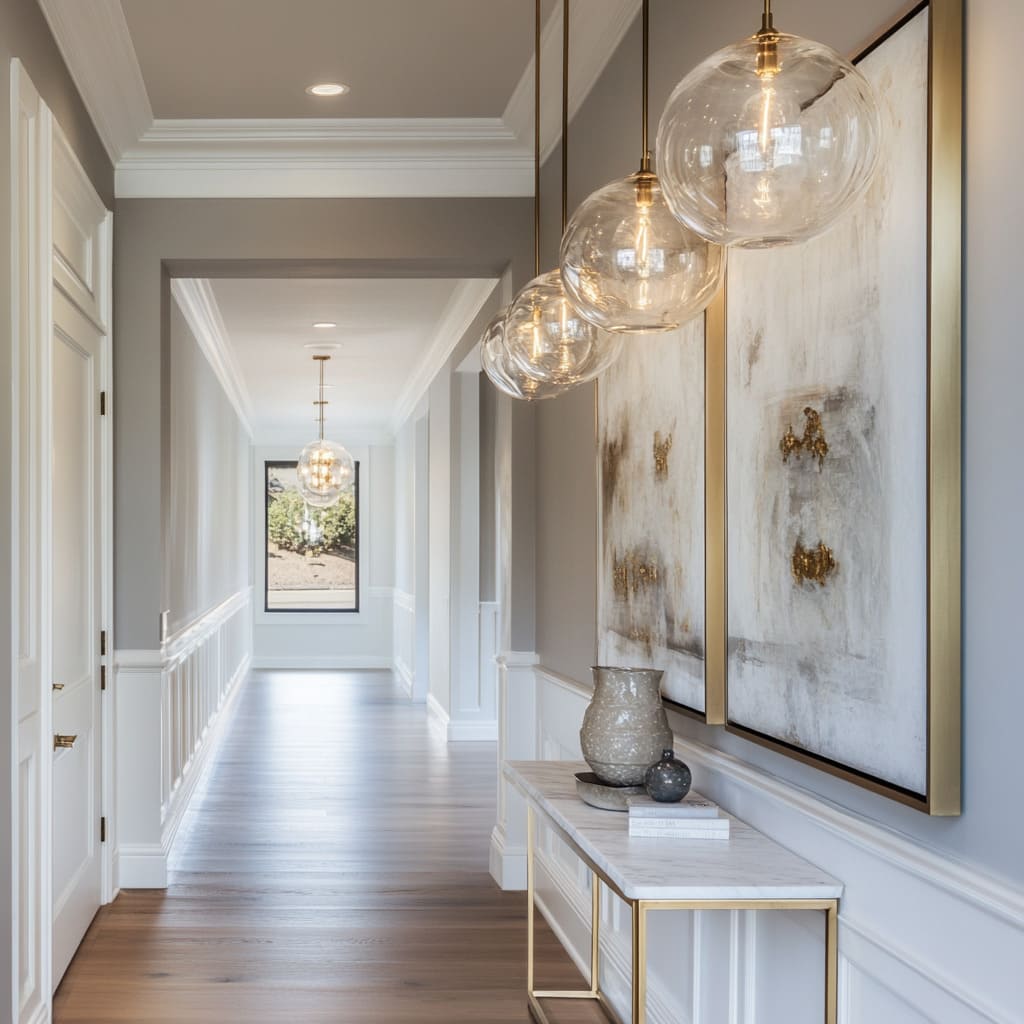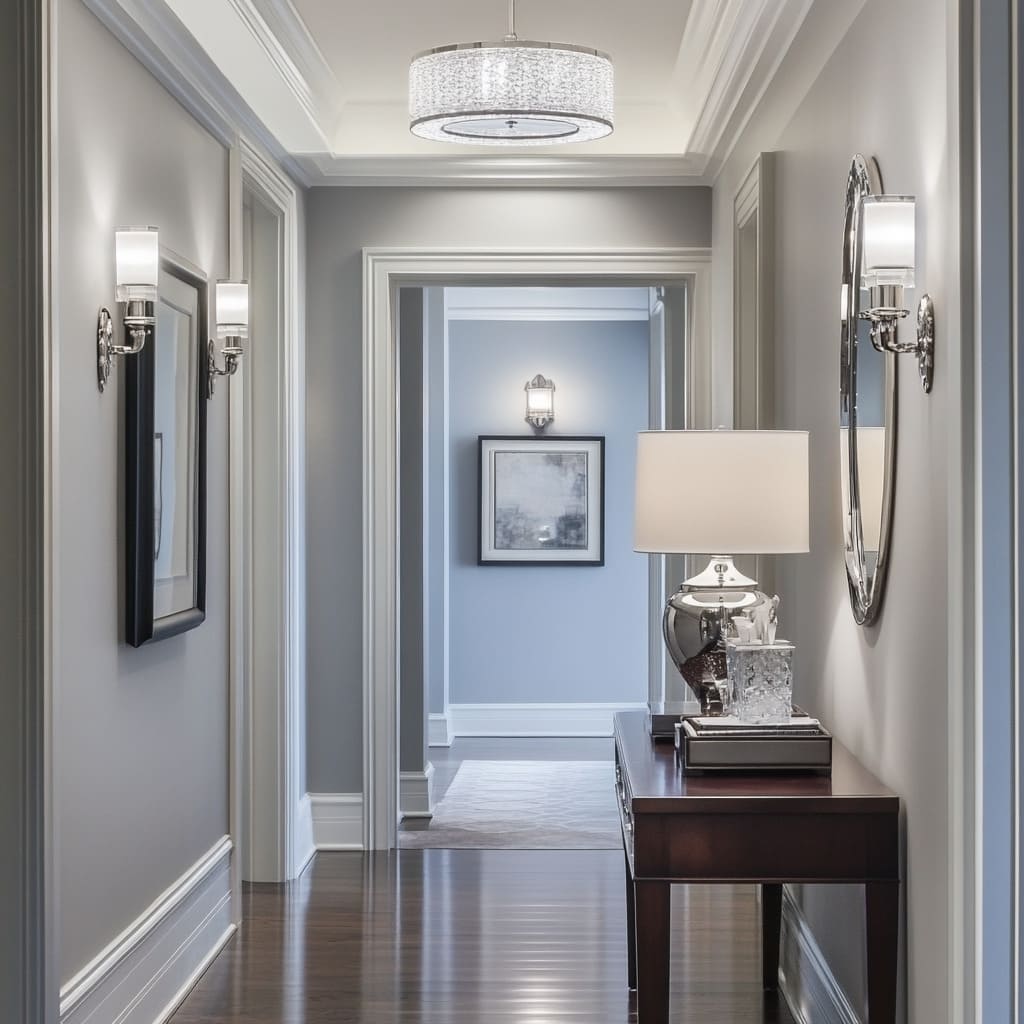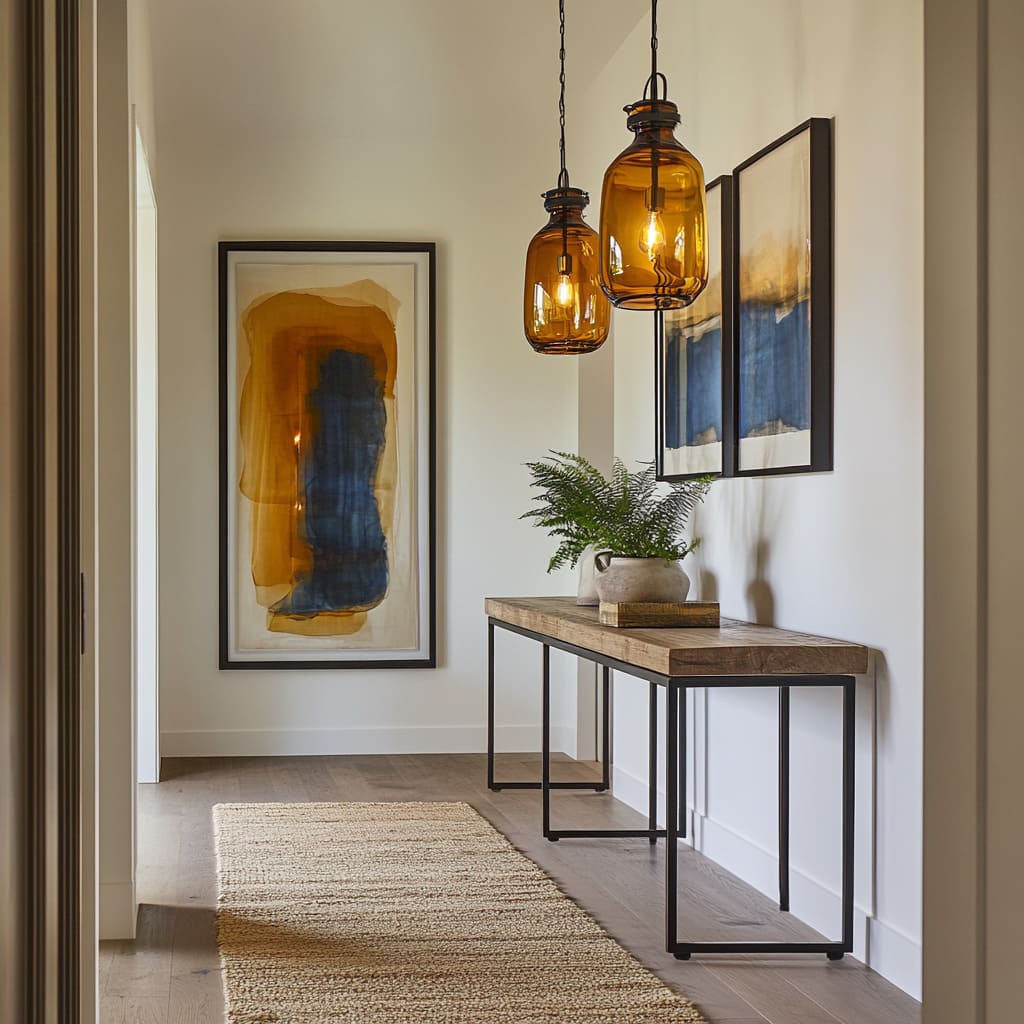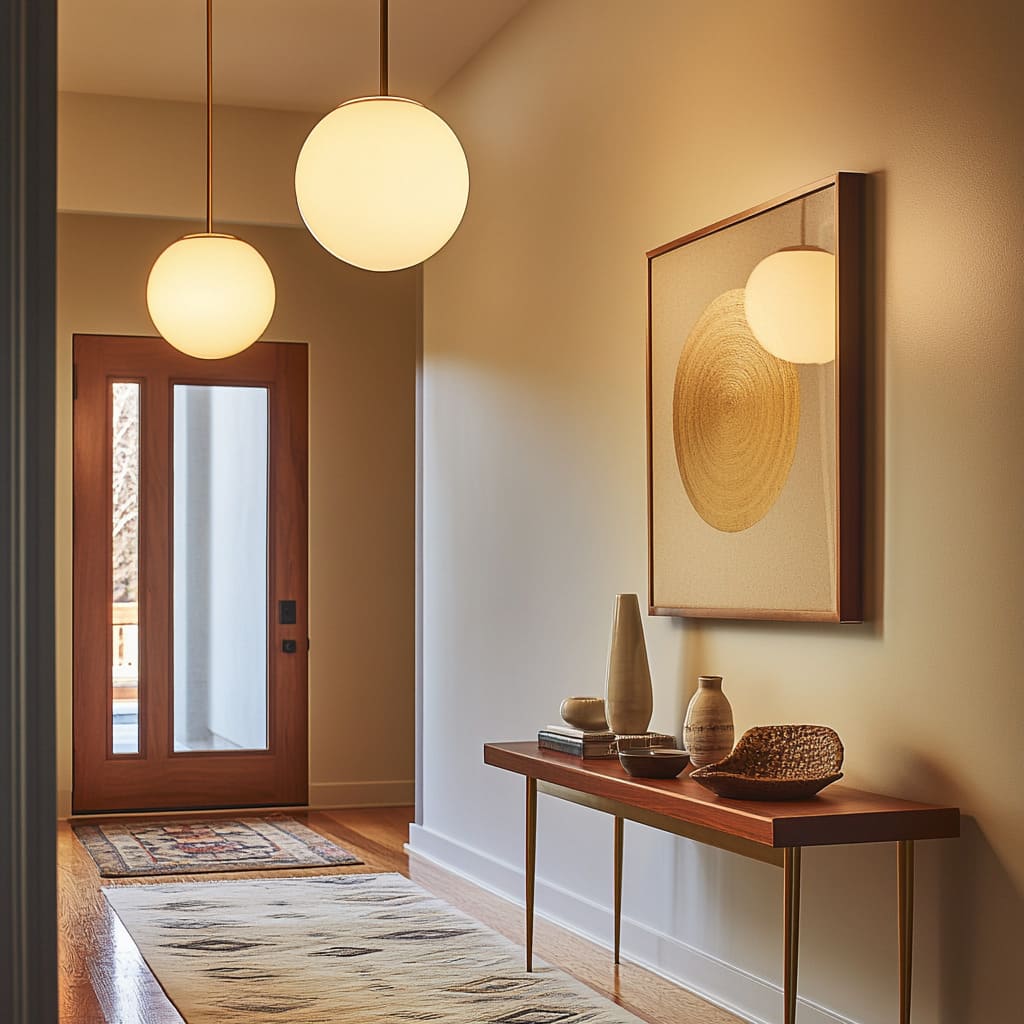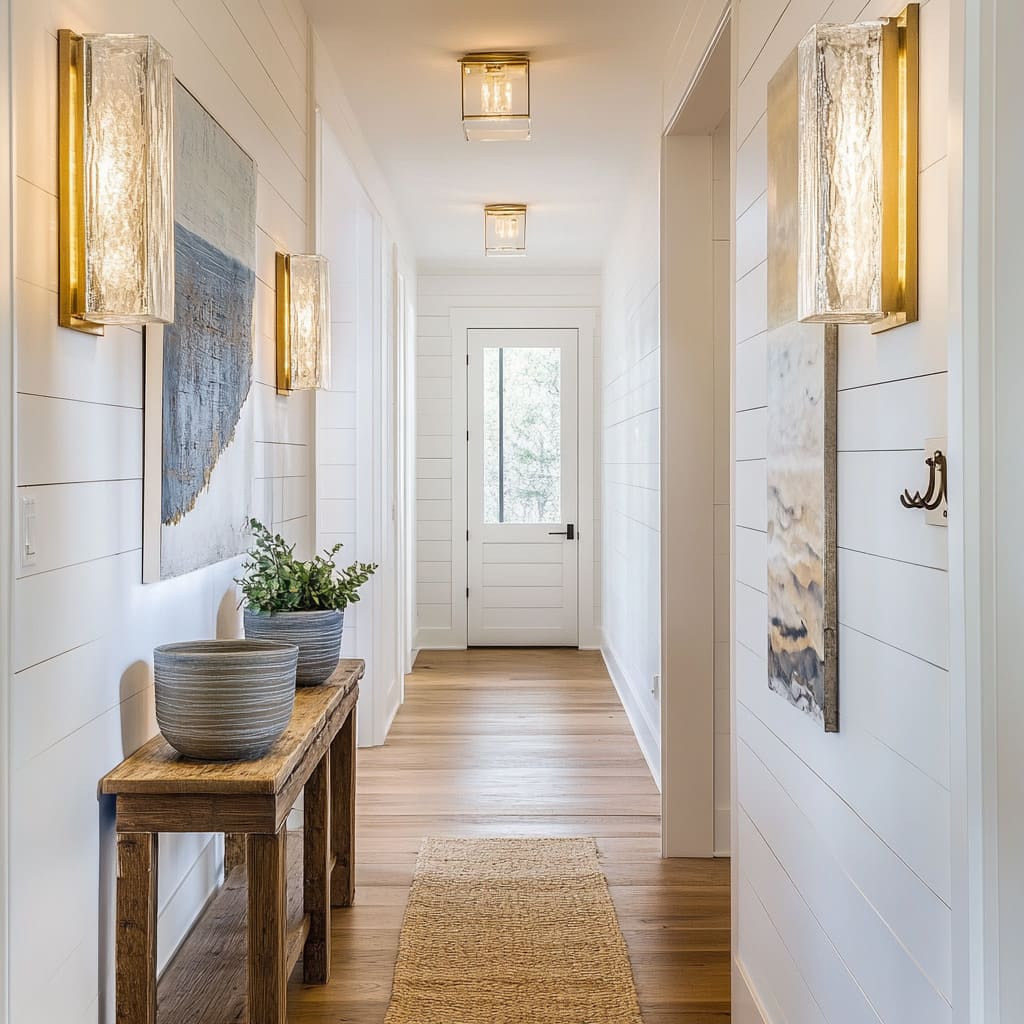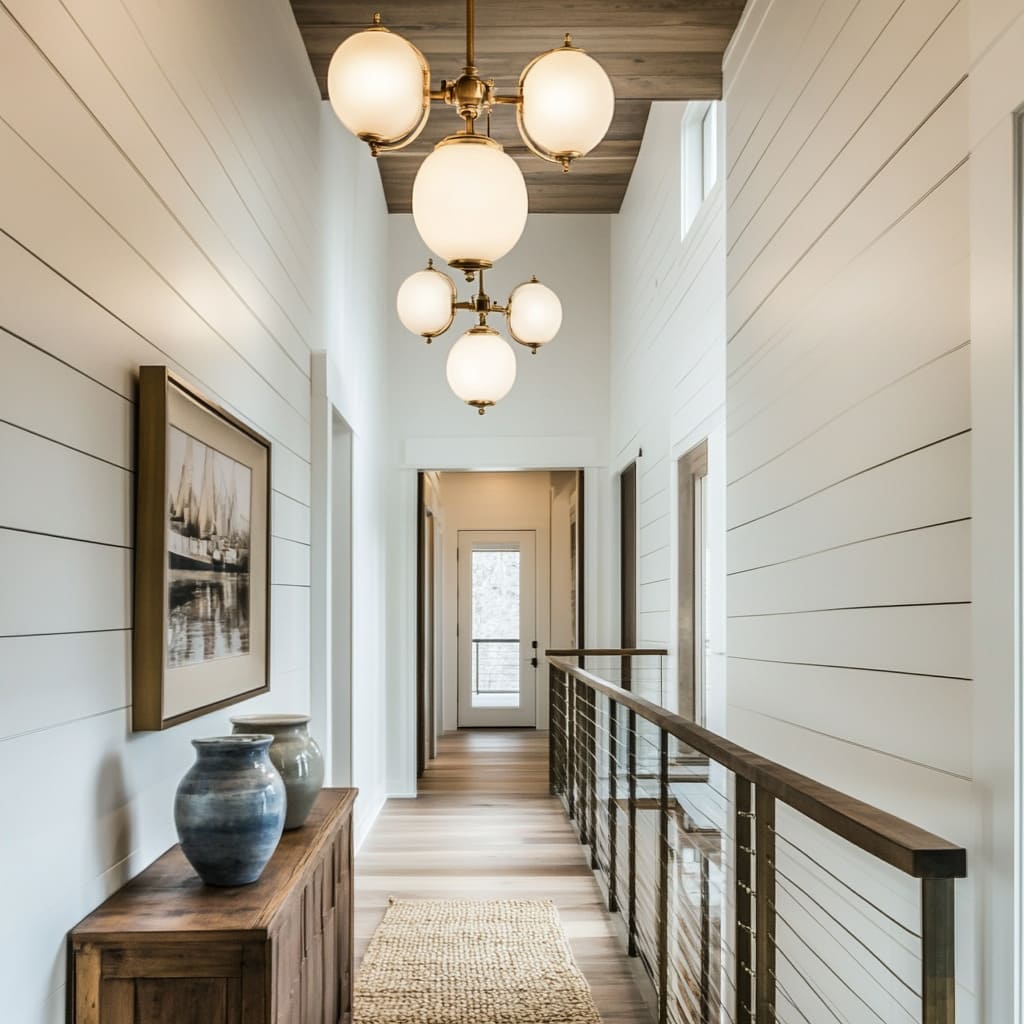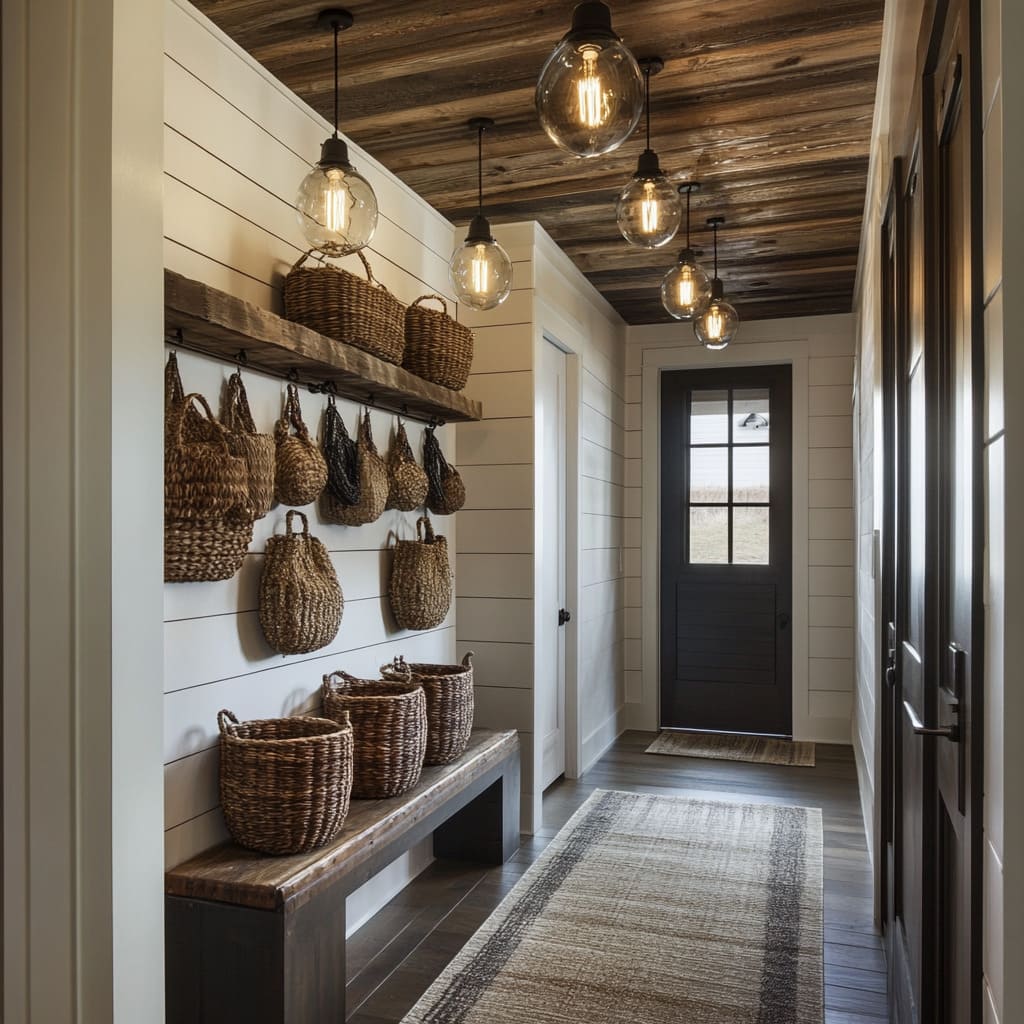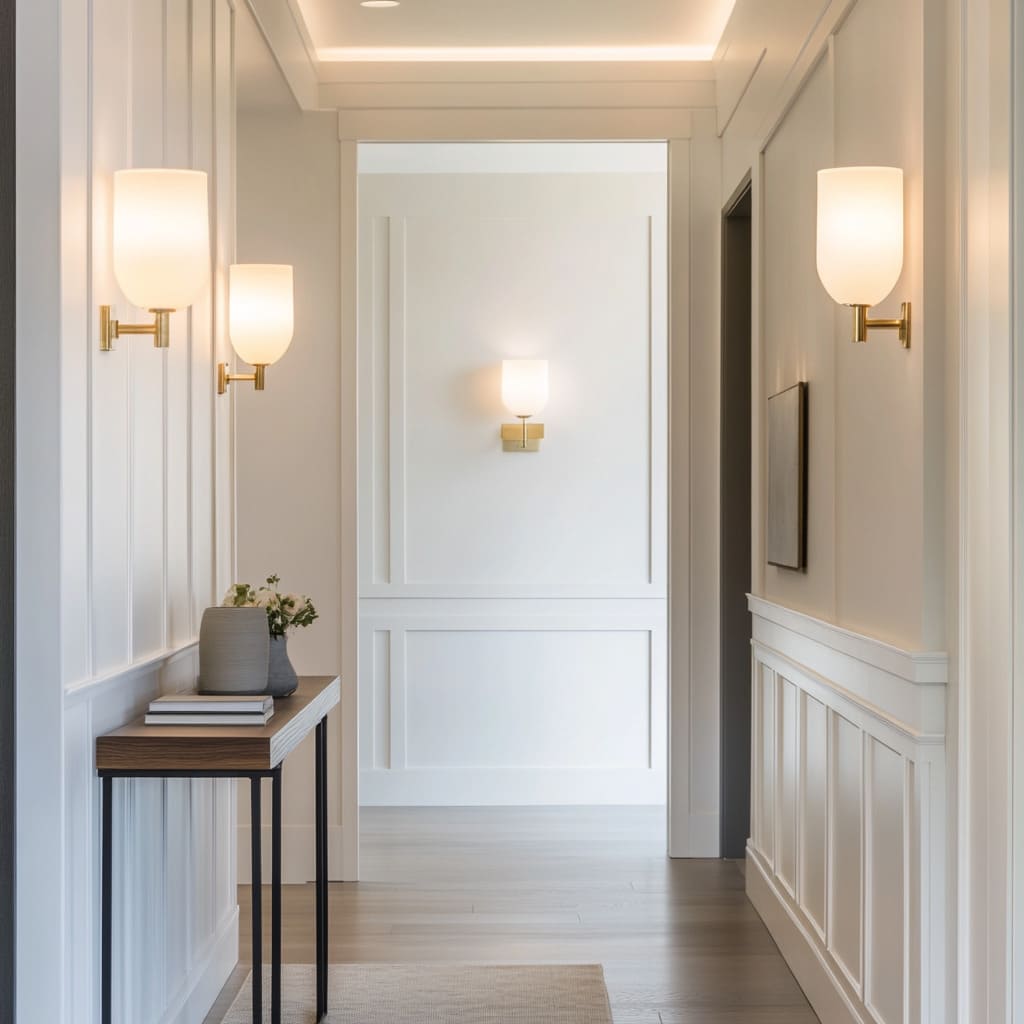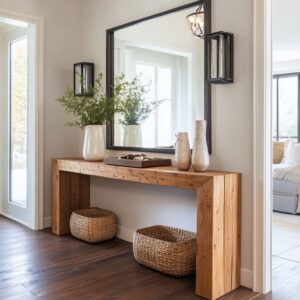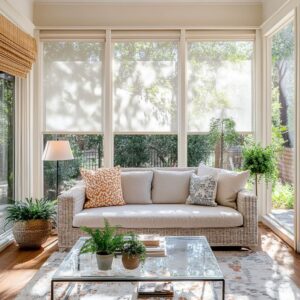A hallway is often one of the most overlooked spaces in a home, yet it plays a key role in setting the atmosphere and connecting different areas. Whether it’s a grand entryway or a narrow corridor, the right design choices can turn it into more than just a passage.
From carefully layered lighting to the perfect balance of textures, a well-designed hallway feels intentional and inviting.
The best hallway ideas focus on more than just aesthetics—they consider functionality, lighting, and how each design element works together. A combination of smart furniture placement, subtle contrast, and well-chosen artwork can make even the simplest space feel complete.
Whether your style leans toward classic charm, modern minimalism, or something in between, small adjustments in color, materials, and decor can bring new life to your hallway. In this guide, we’ll explore ways to refine every detail, from choosing the right textiles to incorporating thoughtful lighting layers.
Whether you’re working with a spacious hallway or a compact space that needs clever solutions, these ideas will help you create a look that feels cohesive and inviting.
Functional Placement of Furniture
Hallways often serve as more than just passageways—they are an opportunity to add function without sacrificing style. The right furniture choices can make a hallway feel purposeful while maintaining an open, uncluttered look.
Whether it’s a slim console table for daily essentials or a well-placed bench for added convenience, thoughtful placement plays a key role in effective hallway design ideas.
Console Tables: Thoughtful Storage Without Clutter
A hallway console table is more than a decorative surface—it’s a practical addition that helps keep everyday items within reach. The best designs balance function and aesthetics, providing a dedicated space for keys, mail, or small decorative accents without making the area feel cramped.
A narrow profile, typically between 12 to 15 inches in depth, ensures it doesn’t disrupt movement, while a lower shelf or open space beneath can house woven baskets for extra storage. Some homeowners opt for a floating console to maintain a light, airy feel, making the space appear less crowded.
Seating That Blends Utility with Style
In larger hallways, a bench can serve both as a visual anchor and a functional seat. Positioned beneath a console or along an empty stretch of wall, it creates a natural resting spot for putting on shoes or setting down bags.
A cushioned bench adds softness to a space filled with hard surfaces, while a wooden or metal frame introduces texture and depth. In some cases, a pair of small ottomans or stools can replace a bench, allowing for flexible seating that can be tucked away when not in use.
How to Make It Work in Your Home
- Choose a slim console that provides surface space without obstructing foot traffic. A depth of 12 to 15 inches is ideal for narrow spaces.
- Add a bench or ottomans if the layout allows. This creates a seating area while enhancing the hallway’s overall design.
- Use storage baskets under the console to keep clutter out of sight while maintaining a clean, polished look.
- Consider a floating console if you want storage without a bulky feel, especially in compact hallways.
A well-planned hallway doesn’t just guide movement—it adds to the flow of daily life. By selecting furniture that balances form and function, you can turn this often-overlooked space into one that works effortlessly with the rest of your home.
Hidden Depth in Color Choices
Color in a hallway does more than cover walls—it defines the atmosphere and subtly shifts the way the space is perceived. The best interior design for hall spaces relies on colors that do more than appear flat.
Small adjustments in undertones or contrast between trim and walls can dramatically change the mood, making a hallway feel more inviting and layered rather than one-dimensional.
The Power of Undertones
A well-chosen shade of white or gray isn’t as simple as it seems. Instead of using pure white, many designers opt for shades with a warm or cool undertone to avoid a stark or sterile effect.
Whites with a soft beige or taupe tint bring warmth, while those with blue or green undertones introduce a cooler, airy feel. Similarly, muted grays often contain subtle hints of blue, green, or even lavender, adding an extra dimension to what might otherwise seem like a neutral choice.
These variations are often imperceptible at first glance, but they influence the way light interacts with the space throughout the day.
Dark Trim and Wainscoting for Contrast
A refined hallway often incorporates contrast to frame the space in a way that feels structured and intentional. Dark-stained wood or painted trim against a lighter wall draws attention to architectural details while giving the space a more polished feel.
Wainscoting in a slightly deeper tone than the walls creates depth without overwhelming the design. This approach is particularly effective in homes that lean toward classic or transitional styles, where structure and definition play a key role.
How to Make It Work in Your Home
- Test colors in different lighting to see how undertones shift throughout the day. Hallways often have limited natural light, so it’s important to observe how artificial lighting interacts with paint colors.
- Use contrast carefully. A slightly darker trim can add sophistication without making the space feel heavy. If your hallway is narrow, a subtle contrast works better than an extreme one.
- Consider muted tones over stark colors. Soft off-whites, smoky blues, or earthy grays can create a refined backdrop that feels more inviting than pure white or deep black.
A thoughtful approach to color makes a hallway feel intentional rather than an afterthought. Even the most subtle choices—like a gray with a greenish undertone or a slightly darker baseboard—can bring richness to a space that might otherwise go unnoticed.
Subtle Use of Contrast and Reflection
A well-designed hallway isn’t just about choosing the right colors or furniture—it’s also about how surfaces interact with light. The right balance between glossy and matte finishes, as well as the strategic placement of reflective elements, can transform even the simplest hallway into a striking space.
Whether dealing with a spacious entryway or looking for narrow hallway ideas, contrast and reflection can be used to shape the overall feel of the area.
Balancing Glossy and Matte Finishes
A polished surface naturally reflects light, making a hallway feel more open and airy. However, too many glossy finishes can create an artificial glare that feels unbalanced.
The best designs counter this effect by combining high-shine elements—such as a lacquered console table, a marble floor, or a metallic-framed mirror—with matte or textured walls. Painted paneling, soft shiplap, or a subtle plaster finish absorbs just enough light to prevent the space from feeling overwhelming.
This contrast keeps the hallway visually interesting while preventing it from looking overly sleek or clinical.
Layered Reflections for a Brighter, More Spacious Feel
Mirrors, metallic accents, and high-shine floors work together to amplify light, giving depth to a hallway without the need for additional fixtures. A large statement mirror placed across from a light source—whether it’s a window, a pendant light, or a set of sconces—bounces illumination throughout the space.
Metallic-framed mirrors, brass sconces, or chrome-finished pendant lights create a similar effect, subtly multiplying the glow without overpowering the design. This layering technique is particularly effective in long or dimly lit hallways, where natural light is limited.
Instead of relying on a single light fixture to do all the work, reflective surfaces distribute brightness more evenly, making the space feel larger and more inviting.
How to Apply This at Home
- If using glossy flooring, opt for matte or lightly textured walls to create contrast and avoid a sterile look.
- Position a statement mirror strategically. Placing it across from a window or light fixture enhances brightness and adds depth.
- Incorporate metallic finishes carefully. A few well-placed brass or chrome accents in light fixtures or furniture details can add just enough reflection without overloading the space.
Even the smallest changes—like swapping out a flat-finish console for one with a subtle sheen or upgrading light fixtures to include metal accents—can make a hallway feel more open and polished. By playing with contrast and reflection, you can bring depth to the space in a way that feels natural and effortless.
Lighting Hierarchy and Gradation
A well-lit hallway isn’t just about adding brightness—it’s about shaping the space through layers of light. A single fixture might illuminate the area, but without variation in placement and intensity, the result can feel flat.
A thoughtful lighting plan balances overhead, mid-level, and accent lighting to create depth and dimension. This approach works especially well for modern hallway ideas, where lighting itself becomes part of the design.
Layered Lighting for a Dynamic Space
Instead of relying on a single overhead fixture, hallways that feel inviting and well-structured use multiple sources of illumination. A combination of pendant lights or chandeliers for general lighting, sconces at mid-level for added warmth, and table lamps or floor lamps for softer accents prevents the space from feeling sterile.
Each layer contributes to the overall composition, ensuring that no harsh shadows dominate the area. Wall sconces, in particular, play an important role in balancing brightness.
Mounted at eye level, they help avoid stark contrasts between overhead lighting and darker lower sections of the hallway. When paired with recessed lights or a statement pendant, sconces bring warmth to the space while creating an even flow of illumination.
Height Variations and Visual Interest
A well-designed hallway draws attention along its length rather than focusing light in a single area. One of the most effective ways to do this is by hanging multiple pendants or chandeliers at different heights.
This staggered placement not only distributes light more evenly but also introduces an element of rhythm, making the hallway feel more dynamic. Even in a smaller space, a grouping of pendant lights can act as a sculptural focal point without taking up valuable floor space.
This technique works particularly well in contemporary interiors, where lighting often doubles as an artistic feature.
How to Apply This at Home
- Incorporate at least two layers of lighting. If you prefer a minimalist look, combine recessed lighting with sconces. If the space allows, add a table lamp or a low-hanging pendant to introduce depth.
- Consider varying fixture heights. Hanging pendants at different levels helps guide the eye along the hallway, making it feel more expansive.
- Use wall sconces to soften harsh shadows. Placing them at mid-height balances the contrast between overhead lighting and darker corners.
By layering different light sources and carefully considering their placement, a hallway can become more than just a transitional space—it can set the tone for the rest of the home. Even the smallest changes, like adding a well-placed sconce or adjusting the height of a pendant, can shift the entire feel of the area, making it more inviting and visually engaging.
Thoughtful Use of Runners and Textiles
A hallway may be a functional space, but that doesn’t mean it has to feel empty or cold. Flooring plays a major role in defining the character of a hallway, but without the right balance of texture and warmth, it can feel incomplete.
This is where textiles—especially runners—become essential. Whether you’re looking for hallway inspiration or a way to make a space feel more cohesive, choosing the right runner can make all the difference.
Runners as a Visual Guide
A well-chosen runner does more than add softness underfoot—it subtly directs movement through the hallway. The length of the runner naturally leads the eye forward, reinforcing the flow of the space.
This effect is even more pronounced in longer hallways, where a well-placed runner helps break up the monotony of a straight passage. Beyond function, patterns and colors in runners can tie together different design elements.
A geometric or striped pattern might echo the shape of wainscoting or align with the lines of recessed lighting, creating a sense of continuity. A soft, faded Persian-style rug can complement traditional interiors, while a modern abstract pattern can add contrast to a minimalist space.
Softening Hard Flooring
Most hallways feature durable surfaces like wood, tile, or stone, which, while practical, can feel too rigid or formal on their own. A runner introduces a layer of warmth, making the space feel more inviting.
Materials like wool or woven jute not only add softness but also help with sound absorption, reducing echoes in long corridors. For homes with patterned tile or intricate herringbone wood flooring, the key is balance.
A solid-colored or subtly textured runner works best, allowing the beauty of the flooring to shine without visual competition. On the other hand, if the floor is neutral, a boldly patterned runner can become a statement piece.
How to Choose the Right Runner
- Match or contrast wisely. A runner should either complement existing decor or introduce a gentle contrast that enhances the space. Consider choosing a color that connects with artwork, furniture, or even light fixtures.
- Think about proportions. For longer spaces, look into long hallway runner ideas that extend almost the entire length of the space while leaving a few inches of visible flooring on either side.
- Choose materials with function in mind. Wool offers durability and softness, jute brings in natural texture, and low-pile synthetics are great for high-traffic areas.
A hallway doesn’t have to feel like just a walkway from one room to another. With the right runner, it becomes an extension of your home’s style, adding warmth, movement, and personality to a space that’s often overlooked.
Coordinating Artwork and Decorative Objects
A hallway isn’t just a passage—it’s an opportunity to introduce character and style through artwork and carefully chosen decor. Whether the goal is to create a statement wall or simply add visual interest, the way art and decorative objects are arranged plays a crucial role in shaping the space.
The best hallway decor ideas use a mix of scale, color coordination, and organic elements to make the area feel cohesive and intentional.
Choosing the Right Artwork and Placement
The scale of artwork matters just as much as the subject itself. In a wide hallway, a single oversized piece can serve as a focal point, anchoring the space with a bold presence.
On the other hand, in narrower spaces, vertical arrangements work best—tall and slim artwork or a stacked series of frames naturally align with the proportions of the walls, preventing the area from feeling crowded. For those who prefer a more curated look, a gallery-style arrangement can be effective.
Mixing different sizes while keeping a consistent theme—such as black-and-white photography, abstract pieces, or nature-inspired prints—creates a cohesive yet dynamic display. Aligning artwork with architectural features, such as wainscoting or sconce placement, adds structure and prevents the display from feeling randomly placed.
Matching Frames and Decorative Accents
One often-overlooked detail in hallway design is how frames and decorative objects relate to lighting and furniture finishes. A well-thought-out design might feature black metal frames that match the legs of a console table or brass-trimmed artwork that reflects the glow of matching sconces.
This subtle repetition of materials ties everything together, making the hallway feel intentionally styled rather than a collection of disconnected pieces. Beyond framed artwork, decorative accents like sculptural vases, bowls, or table lamps on a console table help complete the look.
When chosen with care, these objects enhance the theme without making the space feel cluttered.
Bringing in Natural Elements
Organic motifs soften the structure of a hallway, whether through artwork featuring botanical themes or the addition of greenery in decorative vases. Even in a space dominated by sleek lines and polished finishes, the presence of plants, branches, or floral-inspired artwork brings warmth and balance.
How to Make It Work at Home
- Pick frames and decor that coordinate with lighting or furniture finishes to maintain a unified look.
- Align artwork with existing architectural details like moldings or sconce placement to create balance.
- Use natural elements—whether in the artwork itself or through real plants—to introduce softness and depth.
A well-decorated hallway can set the tone for the rest of the home. With thoughtful placement, complementary materials, and a mix of textures, even the simplest hallway can feel like a curated, welcoming space.
Balance Between Traditional and Contemporary Details
A well-designed hallway doesn’t have to lean entirely toward one style—combining classic and modern elements can create a dynamic look that feels timeless yet fresh. The best interiors blend traditional details, like intricate moldings or vintage-inspired chandeliers, with sleek, minimalist accents.
This contrast keeps the space visually engaging and prevents it from feeling outdated or overly trendy. Whether updating an older home or adding warmth to a contemporary space, the right balance can transform the hallway into a refined yet welcoming part of the home.
Blending Ornate and Sleek Elements
One of the most effective ways to create contrast is by pairing decorative architectural details with streamlined furniture. Wainscoting, crown molding, or paneled walls bring depth and a sense of history, while a modern console table or contemporary lighting keeps the look balanced.
A hallway with intricate wall detailing might feel overly traditional on its own, but introducing elements like a black metal-framed console or an abstract art piece shifts the style toward something more current. The same idea applies to lighting.
A classic chandelier with crystal or brass detailing can be paired with modern wall sconces, creating a layered effect where no single element dominates. This mix of influences adds personality, making the hallway feel thoughtfully designed rather than strictly formal or purely minimalist.
Neutral Palettes as a Backdrop
Color plays a crucial role in blending traditional and contemporary features. Most hallways benefit from soft, neutral wall tones like white, beige, or muted gray.
These shades provide a clean backdrop for both ornate and modern accents, ensuring they don’t compete for attention. A deep blue or charcoal gray can also work well, adding a rich, moody effect while still allowing lighter furniture or artwork to stand out.
How to Apply This in Your Home
- Pair traditional architectural details with modern furniture. A hallway with wainscoting or paneling can be balanced with a sleek console table or minimalist decor.
- Use contrast in lighting. A grand chandelier can work beautifully alongside contemporary wall sconces or sculptural pendant lights.
- Let the wall color set the tone. A neutral backdrop keeps the mix of old and new feeling intentional rather than chaotic.
- Choose a statement piece. A modern mirror, abstract painting, or sculptural accent can help bridge the gap between styles.
A hallway doesn’t have to be strictly one aesthetic or another. With the right balance of traditional detailing and modern finishes, the space can feel polished, layered, and timeless.
If you’re looking for hallway furniture ideas, consider pieces that contrast with the existing architecture—this will keep the design feeling fresh without losing its character.
Conclusion
Hallways can be transformed into striking areas by carefully considering lighting layers, thoughtful furnishings, and the interplay of textures. Small details—like matching metal finishes, choosing a nuanced paint color, or positioning mirrors to amplify light—can have an outsized impact on a narrow or transitional space.
When planning your own design, focus on how you want people to feel while passing through. By layering a few well-chosen materials, fixtures, and accents, the hallway becomes a memorable extension of your home’s overall character rather than just a mere passage.
This deeper look reveals the hidden strategies at work in high-quality hallway designs. Feel free to adapt these principles in ways that suit your space, giving special care to lighting, layout, and materials, and you’ll end up with a hallway that feels both useful and visually cohesive.
